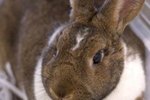
When you picture a ferret, you might be thinking, small, furry, long, and darkish. Many ferrets are indeed brown or black; others feature a lot of those colors. But some don't have a trace of color beyond white or yellow. These are albino ferrets.
About Albino Ferrets
Albino ferrets have pale fur simply due to DNA quirks. These changes stop the emergence of pigmentation in ferrets, hence their color-free state. Albino ferrets are usually snow white in coloration but also sometimes are yellow or yellowish-white. Their eyes are crimson and their skin is pink -- both due to the presence of red blood cells underneath.
Skin Oils
A white albino ferret could turn yellowish because of the oils that the creature's sebaceous glands give off, particularly those of male ferrets who are not fixed. Mature ferrets who have not undergone spaying or neutering surgeries possess much bigger skin glands than their fixed counterparts. These oils have multiple purposes, including communication to fellow ferrets and defense against water and low temperatures. The more oil built up in the albino ferret's fur the yellower the little guy appears. Apart from yellowish coloring, these oils frequently cause ferret coats to take on oily textures.
Seasons
It is relatively common for albino ferrets to develop totally white appearances during the winter months, only to look conspicuously yellow as the weather heats up. Ferret coat colors frequently change depending on the season, and this is in no way limited to the albino variety.
Aging
An albino ferret might also turn yellow due to the natural aging process. If your pet started life with totally white fur, don't be shocked as he slowly takes on a noticeable yellowish tone, particularly after the age of reproductive maturity.
References
- Ferrets, Rabbits and Rodents; Katherine E. Quesenberry and James W. Carpenter
- The UFAW Handbook on the Care and Management of Laboratory and Other Research Animals; Robert Hubrecht and James Kirkwood
- Modern Ferret: Modern Ferret Magazine Issue #30
- The Ferret Handbook; Gerry Bucsis and Barbara Somerville
- Ferret Health Advancement at Michigan State University: Pathology of the Domestic Ferret
- SmallAnimalChannel.com: Ferrets
Photo Credits
-
Creatas/Creatas/Getty Images



